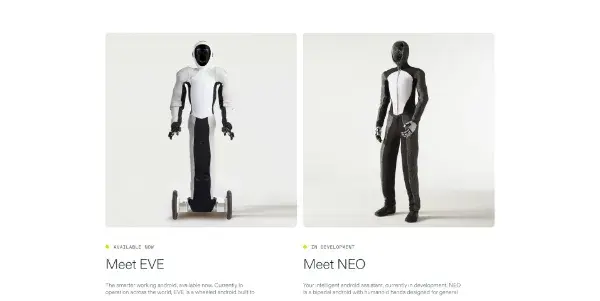NEO by 1x Technologies

A bipedal intelligent android assistant with humanized hands under development. The project is supported by OpenAI
NEO by 1x Technologies: A Glimpse into the Future of AI Assistants
1x Technologies is pushing the boundaries of artificial intelligence with its ambitious project, NEO – a bipedal intelligent android assistant. Supported by OpenAI, NEO represents a significant leap forward in robotics and AI integration, promising a powerful and versatile tool with practical applications across numerous industries. While still under development, the project generates considerable excitement due to its unique blend of advanced robotics and sophisticated AI.
What NEO Does
NEO is not simply a chatbot or virtual assistant; it's a physical embodiment of AI. This bipedal android is designed to interact with the world in a human-like way, using its humanized hands for manipulation and its advanced AI for understanding and responding to complex commands and situations. Its capabilities extend beyond simple task completion, encompassing learning, adaptation, and problem-solving in dynamic environments. Essentially, NEO aims to bridge the gap between virtual AI and physical interaction, offering a more intuitive and effective human-machine interface.
Main Features and Benefits
- Bipedal Locomotion and Dexterous Manipulation: NEO's ability to move freely and interact with objects using its hands sets it apart from other AI assistants. This allows for a broader range of tasks and applications.
- Advanced AI Capabilities: Powered by OpenAI's technology, NEO boasts sophisticated natural language processing (NLP), computer vision, and machine learning capabilities. This translates to a more nuanced understanding of human commands and contextual awareness.
- Adaptability and Learning: NEO is designed to learn and adapt to its environment and user preferences over time, becoming more efficient and personalized with continued use.
- Human-like Interaction: The anthropomorphic design fosters a more natural and intuitive interaction compared to purely digital AI assistants.
Use Cases and Applications
The potential applications of NEO are vast and span several industries:
- Healthcare: Assisting medical professionals with tasks like medication dispensing, patient monitoring, and providing companionship to patients.
- Manufacturing and Logistics: Performing repetitive tasks, transporting materials, and conducting quality control inspections in factories and warehouses.
- Customer Service: Providing in-person assistance to customers in retail settings or other public spaces.
- Home Automation: Managing smart home devices, assisting with household chores, and providing security.
- Research and Development: Serving as a platform for testing and refining new AI algorithms and robotic technologies.
Comparison to Similar Tools
Unlike purely software-based AI assistants like Siri or Alexa, NEO's physical embodiment significantly expands its capabilities. While virtual assistants excel at information retrieval and simple commands, NEO can interact with the physical world directly, offering a level of practical assistance currently unmatched. Other physical robots exist, but few combine the advanced AI capabilities and human-like dexterity seen in NEO's design. This unique combination positions NEO as a pioneering tool in the field.
Pricing Information
NEO is a paid product, but specific pricing details are not yet publicly available. Given the complexity and advanced technology involved, it is expected to be a high-cost solution, likely targeted towards businesses and research institutions with significant budgets. Further pricing details will be released as the product progresses through its development stages.
Conclusion
NEO represents a significant advancement in the field of AI and robotics. Its potential to revolutionize various industries is undeniable. As development continues, we can anticipate further refinements and an expansion of its capabilities, solidifying its position as a leading example of the next generation of intelligent android assistants. The future of human-robot interaction may well be shaped by projects like NEO.